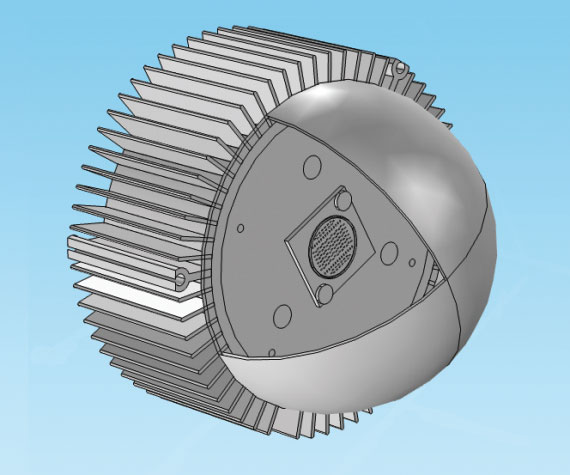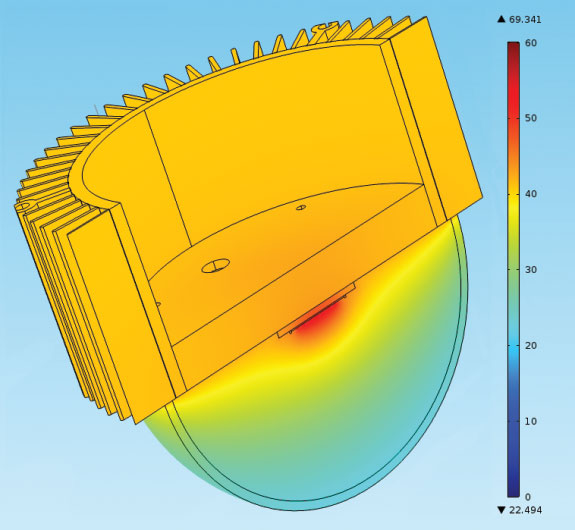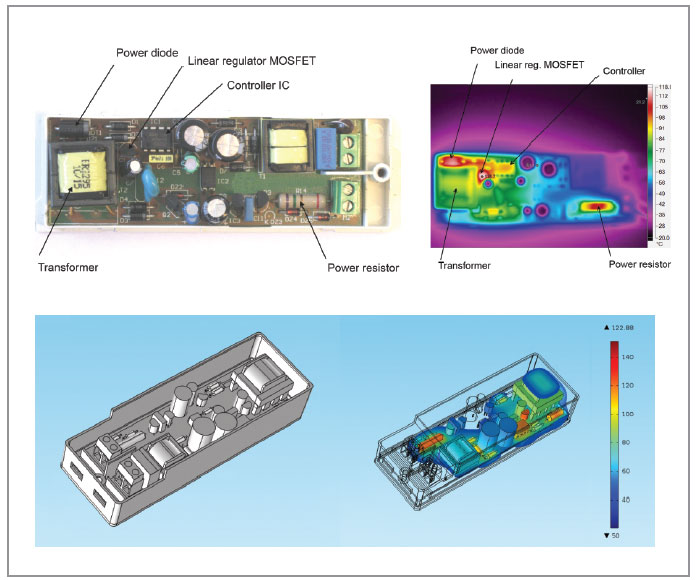Gets More Manageable Through Simulation
Fast and accurate design and validation methods for price-sensitive and high volume products like lighting devices can make all the difference in the bottom line.
Light-emitting diode (LED) light sources are continually displacing incandescent lighting in general lighting environments.
The reasons for this are that LED lights have relatively long life spans; they possess a high luminous efficiency; and they are environmentally friendly.
Though LEDs have quickly become ubiquitous in general lighting environments, the number of applications for them beyond lighting has grown even faster. These new applications now range from video displays to advanced communications technologies.
A warm glow from a cool competitor: LED light bulbs offer a long-lasting and environmentally friendly option in lighting.
But LEDs don’t come without a few drawbacks. LED lights generally cost more than their incandescent cousins, and their temperature has to be carefully regulated. This heat issue stands in stark contrast to traditional lighting sources, in which heat is actually needed in order for the device to produce a significant amount of visible light.
To understand how the LED industry meets the demands of thermal design and management while still controlling costs, a short primer on what makes up an LED is helpful (see Figure 1). An LED light is normally composed of an LED module, lenses or diffusers, an LED driver, a heat sink, thermal interface materials (TIMs), and a body that holds these parts together.
Most of the high-power LED modules used in general lighting are built using a large number of
 LEDs mounted on a substrate. This solution is the most efficient from a thermal point of view, since the substrate itself conductsheat well. When this substrate is mounted effectively on an efficient heat sink, the heat is released into the ambient air. Since the adjacent surfaces of the LED module and the heat sink are not entirely smooth, some amount of thermal interface material (TIM), typically thermal grease, is added between the surfaces. Highly polished surfaces need only a very small amount of grease.
LEDs mounted on a substrate. This solution is the most efficient from a thermal point of view, since the substrate itself conductsheat well. When this substrate is mounted effectively on an efficient heat sink, the heat is released into the ambient air. Since the adjacent surfaces of the LED module and the heat sink are not entirely smooth, some amount of thermal interface material (TIM), typically thermal grease, is added between the surfaces. Highly polished surfaces need only a very small amount of grease.
This is exactly the same solution used between microprocessor components and the heat sink in a computer. The use of grease (or any other TIM) is vitally important because any air gap between the hot surface and the heat sink creates extremely high thermal resistance between the surfaces.
Heat removal is critical in LEDs because, unlike conventional light sources, LEDs need to operate at the lowest possible temperature. If the temperature is increased, light production is reduced, and the lifetime of the LED is reduced.
In relation to LEDs, temperature refers specifically to what is known as the junction: the small active area where light generation takes place. In order to keep the LED junction at the lowest possible temperature, an efficient heat sink is usually needed.
Since the management of heat in LEDs is regulated largely by the convection of heat into the ambient air, the design of the heat sink is crucial (see Figure 2). While aluminum is excellent at conducting heat, it is an expensive material to use in LED applications; the shape of the heat sink becomes even more critical to ensuring efficient heat management when less efficient conductors are used.
It is in this context that research manager Aulis Tuominen and researcher Mika Maaspuro at
 Business and Innovation Development Technology (BID) at the University of Turku in Finland set out to design the most efficient heat sink for an LED lighting device, with COMSOL Multiphysics at their sides. Using simulation tools was critical to their research.
Business and Innovation Development Technology (BID) at the University of Turku in Finland set out to design the most efficient heat sink for an LED lighting device, with COMSOL Multiphysics at their sides. Using simulation tools was critical to their research.
“The overall size of the heat sink or any geometrical dimension of some structure or material parameter can easily be changed in the simulation model,” explains Maaspuro. “Repeating the simulation of the model while using different geometrical dimensions or other design parameters provided important data about the thermal behavior of the LED lighting device. Thisinformation hardly can be found otherwise. Building prototypes is too expensive and time-consuming.”
Getting the simulations and models to match the physical prototypes as accurately as possible is critical to making the development of new LED systems fast while reducing costs.
Toni Lopez, a researcher at the industrial giant Philips, set out to determine just how accurately the physical prototypes matched the models developed in COMSOL Multiphysics. Lopez performed extensive experimental validation of the simulations he had done of electrothermal analyses of highpower LEDs. These tests revealed that the simulations accurately predicted self-heating, current crowding, forward voltage, and other relevant performance indicators for LED-based devices.
The accuracy of the models in reflecting physical prototypes is critical, but the ability of COMSOL Multiphysics to manage complicated thermodynamic theory makes actually developing the models simpler and more accurate.
“The theory of thermodynamics and the use of the many empirical equations needed to do these studies simply do not provide accurate enough results,” says Maaspuro. “This alternative would also require deep knowledge of thermodynamics, and it can be hard to find such an expert.” He adds, “The use of a FEA software tool is an easier way to solve these kind of problems. The differences between alternative design solutions may be small, but in highly price-sensitive and high-volume products like lighting devices, the differences are important to know.”
In addition to the heat-sink design Maaspuro worked on, he and his colleagues have also looked into the effects that TIMs and thermal grease have in LED lighting devices and how these in turn impact the junction temperature of the LEDs.
“ There are 2 materials especially nanomaterials, that have much higher thermal conductivity than widely used silicone-based materials,” says Maaspuro. “By using simulations, the effect of these new materials on the thermal behavior of the LED lighting device can be figure out before any sample of that new material is even available for testing.”
The research of Maaspuro and his colleagues has been a revelation to the industrial partners who supported it and were looking to improve the reliability of LEDs and LED drivers. These companies produce LED lighting devices for various applications, including indoor general lighting, outdoor lighting (e.g., road or pedestrian way lighting), and special lights for the automotive industry.
For the larger companies that participated in this research project, like Hella Lighting, modeling and simulation have become the ways products are developed.
“When designing high-power LED luminaires with high efficiency and long lifetimes, thermal LATION
management and optical completeness are the fundamentals,” explains Sami Yllikäinen, R&D and product manager for Signal Lights at Hella Lighting Finland Oy. “In both these fields, Hella uses simulation programs to save development time and costs. Physical prototyping will only be done to verify the finished 3-D design.” (see Figure 3b). “Some of these companies had already used FEA tools in thermal studies,” says Maaspuro. “But for many of the smaller to medium-sized companies, this was something quite new. They had always found their solutions by using prototyping and leveraging their experience with previous designs.
But I think we managed to convince the companies of the power of simulation software in thermal
studies.”
 One such medium-sized company involved with the project, Helvar Oy Ab, which builds LED drivers, foresees product development starting at a much more advanced stage than ever before because of these simulation models.
One such medium-sized company involved with the project, Helvar Oy Ab, which builds LED drivers, foresees product development starting at a much more advanced stage than ever before because of these simulation models.
“By using COMSOL Multiphysics, our know-how is at a much higher level when starting a real product development project,” says Raimo Laitinen, project manager for Helvar. “Besides that, temperature simulation will give us more information before a real prototype is built (see Figure 3c). Prototypes are still needed in the future, too, to ensure that product lifespan and other required product features can be reached.”
In the near future, Maaspuro will be using simulation to examine the driver of the LED (see Figures 3a and d). With this type of electronics, electromagnetic interference and electromagnetic compatibility (EMI/ EMC) issues are important, which will pose an entirely new and challenging task for the researchers.
“We will need a lot of computing power and computer memory not usually available in a normal desktop or laptop PC,” says Maaspuro. “Cloud computing is a relatively new service, and the newest version of COMSOL Multiphysics software supports cloud computing. This could be the solution to obtaining the needed computing power.”






